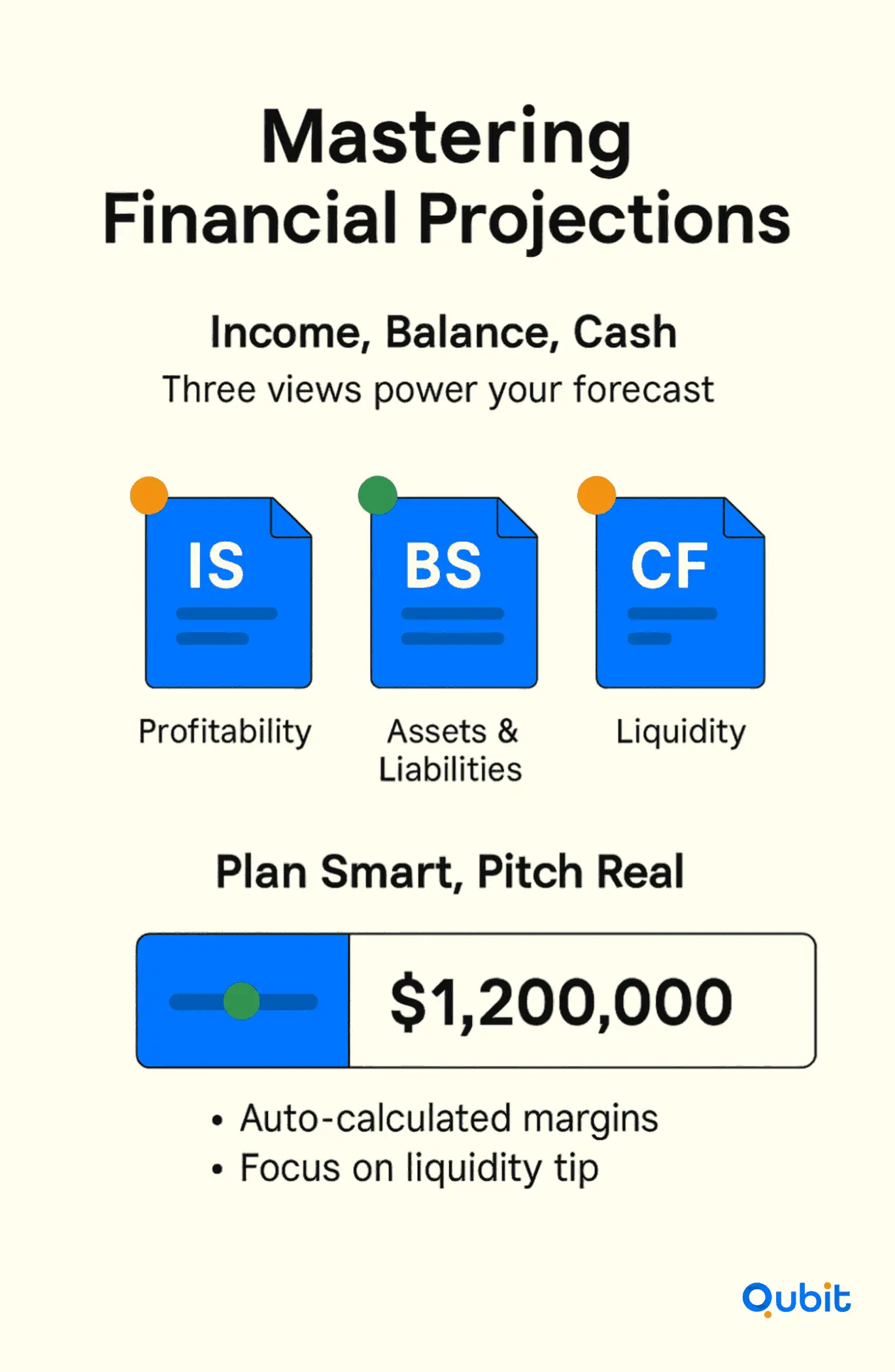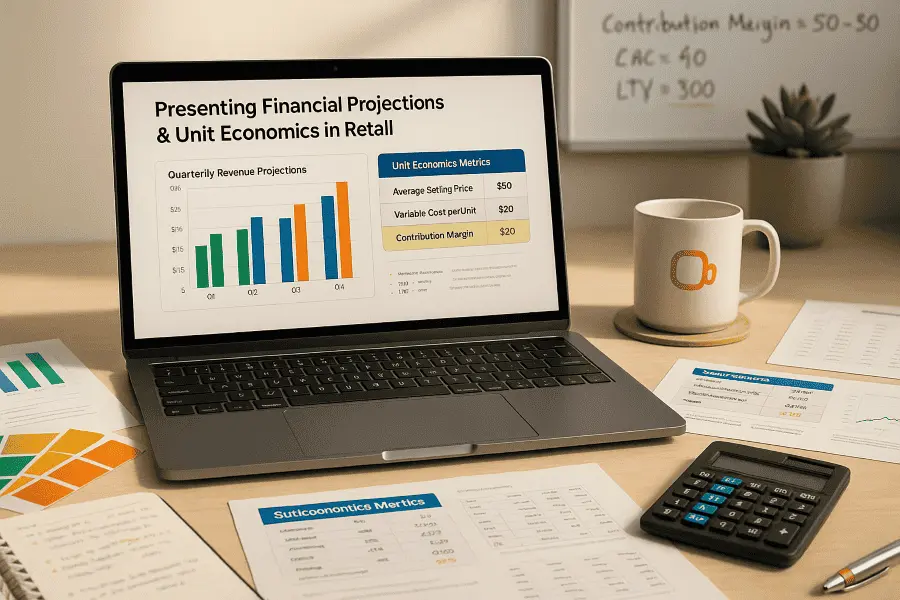Financial projections and unit economics are the backbone of any retail startup’s success. These tools not only help entrepreneurs understand their business’s financial health but also play a pivotal role in attracting investors and securing funding. This article delves into the essentials of crafting and presenting these critical metrics, offering actionable insights for retail startups aiming to thrive in competitive markets.
Your analysis of financial projections finds a complementary layer in retail startup fundraising strategies, where nuanced methods for obtaining capital in retail are discussed. Together, these elements form a roadmap for building a sustainable and scalable retail business.
Let’s explore how to develop, analyze, and present financial projections and unit economics tailored to retail startups.
Mastering Financial Projections Fundamentals in Retail
Financial projections serve as a roadmap for retail businesses, offering a glimpse into potential future performance based on historical data and industry benchmarks. These projections rely heavily on key financial documents, including income statements, balance sheets, and cash flow statements. Each document plays a unique role in shaping a comprehensive financial narrative.

For example, income statements highlight profitability, while balance sheets provide a snapshot of assets and liabilities. Cash flow statements, on the other hand, track the movement of money in and out of the business, ensuring liquidity is maintained.
To dive deeper into the essential statements, refer to Key financial documents necessary for preparing financial projections.
Retail entrepreneurs can also benefit from professional guidance during the early stages of financial planning. Using the free Ankorstart programme can significantly streamline early financial planning for independent retailers, ensuring projections are both realistic and persuasive.
Ultimately, accurate financial projections not only attract investor interest but also guide operational decisions, helping businesses stay on track toward their objectives.
Effective Sales Forecasting for Retail Startup
Sales forecasting is a cornerstone of strategic decision-making in retail. It empowers businesses to make informed choices about inventory management, workforce planning, and market positioning. By analyzing historical sales trends, retailers can identify patterns that inform future projections.
For instance, consulting resources like Referenced for advising new store owners to perform market research to understand local trends can refine forecasting strategies by incorporating actionable market data.
Retailers must also consider macroeconomic indicators to align their forecasts with broader industry benchmarks. For example, the projected $5.42 trillion in U.S. retail sales by 2025, representing a 2.7–3.7% growth rate, highlights the sector's expansion potential. This data serves as a valuable reference point for creating forecasts that are both ambitious and realistic.
Flexibility is another critical component of effective forecasting. Retail environments are increasingly affected by supply chain disruptions and unpredictable market events. Incorporating insights on market disruptions and evolving supply chain conditions into scenario-based forecasting models allows businesses to adapt to fluctuations in raw material availability and logistical challenges.
For retailers looking to present their forecasting data effectively, retail pitch deck design tips offer guidance on linking numerical analysis with compelling visual storytelling. This ensures that forecasts are not only accurate but also persuasive when shared with stakeholders.
By integrating historical trends, macro-level indicators, and flexible modeling, retailers can create forecasts that drive smarter decisions and sustain growth, even in volatile markets.
Strategic Expense Projections for Retail Startups
Effective expense forecasting is crucial for early-stage retailers aiming to maintain financial stability and growth. Understanding procurement expenses, optimizing technology use, and exploring innovative financing options can significantly impact budget management.
Retailers must account for inflation-driven challenges, such as rising product costs due to inflation, by adjusting procurement schedules and forming cost-saving partnerships. For instance, securing stock upfront through a 90-day interest-free payment plan can help mitigate inflation risks while controlling initial cash outlays. This approach ensures inventory availability without immediate financial strain.
Marketing expenditures also demand strategic planning. Initiatives like customer loyalty programms can influence expense projections by fostering brand loyalty and improving customer retention. These programs often require upfront investment but can lead to long-term savings in customer acquisition costs.
Overhead allocations, including technology investments, play a pivotal role in reducing excess costs. Retailers can adopt tools that streamline operations, optimize inventory management, and enhance overall efficiency. Additionally, incorporating frameworks like retail market sizing tam sam som provides clarity on market opportunities, enabling better alignment of expenses with growth potential.
By combining these strategies, retailers can create a robust financial plan that balances operational needs with long-term profitability.
Robust Cash Flow Forecasting Techniques for Retail Startups
Effective cash flow forecasting is essential for retail businesses aiming to maintain financial stability and achieve profitability. By systematically tracking cash inflows, such as sales revenue and investor contributions, alongside outflows tied to operational expenses, businesses can gain a clear picture of their financial health. Regularly reviewing cash flow statements ensures that decision-makers can identify trends and adjust strategies to sustain liquidity.
One critical tool in this process is the break-even analysis, which helps businesses determine the point at which revenues cover costs. This analysis is important for calculating when a company will become profitable in cash flow forecasting.
To strengthen forecasting accuracy, businesses should adopt a disciplined approach to monitoring financial metrics. This includes setting up periodic reviews to compare actual cash flow against projections and adjusting for unexpected variances.
Additionally, aligning these insights with broader business goals can create a cohesive financial strategy. For instance, integrating cash flow data into a retail startup pitch deck can enhance the narrative structure of presentations.
By combining precise tracking, break-even analysis, and regular reviews, retail businesses can not only safeguard liquidity but also position themselves for long-term profitability.
Mitigating Risks through Contingency Planning for Retail Startups
Retail businesses are no strangers to unexpected challenges, from supply chain disruptions to sudden shifts in consumer demand. Identifying potential risks early is the first step toward ensuring operational stability. For instance, retailers should regularly assess vulnerabilities in their supply chains, such as reliance on single suppliers or regions prone to natural disasters. Diversifying suppliers and maintaining safety stock can act as a buffer against unforeseen interruptions.
Another critical strategy is monitoring market trends and consumer behavior. By analyzing data, businesses can anticipate demand fluctuations and adjust inventory or marketing efforts accordingly. This proactive approach minimizes overstocking or stockouts, which can erode profitability.
Developing a robust contingency plan also involves financial preparedness. Establishing alternative financing options, such as credit lines or partnerships with financial institutions, ensures liquidity during crises. Additionally, cross-training employees can help maintain operations when staffing shortages occur.
Retailers must also prioritize communication. Clear protocols for informing stakeholders, employees, suppliers, and customers, during disruptions can prevent confusion and maintain trust.
Data-Driven Decision-Making for Retail Startup Growth
Strategic decisions in retail thrive on clarity, and comprehensive financial projections provide the foundation for that clarity. By forecasting potential outcomes, retailers can allocate resources effectively, ensuring every dollar spent aligns with their growth objectives. Whether planning a product launch or evaluating expansion opportunities, these projections act as a roadmap, guiding businesses toward informed choices.
Continuous feedback loops further enhance this process. By regularly comparing actual performance against projections, retailers can refine their assumptions and adjust strategies in real time. This iterative approach not only minimizes risks but also ensures that decisions remain grounded in current market realities.
For example, a retailer considering a new product line can use projection data to assess profitability, market demand, and resource requirements. If initial sales data deviates from expectations, feedback loops enable swift recalibration—whether that means adjusting marketing efforts or rethinking inventory levels.
Adopting data-driven decision-making empowers retailers to confidently manage growth while mitigating risks. It transforms uncertainty into actionable insights, ensuring that every strategic move is backed by evidence rather than guesswork.
Agile Updates and Adjustments to Projections
Retail markets are constantly evolving, making static financial projections a risky approach. To stay ahead, businesses must regularly revisit their assumptions and incorporate fresh data into their forecasting models. This iterative process ensures that projections remain aligned with current market conditions and operational realities.
Updating financial forecasts is not just about numbers; it’s about understanding shifts in consumer behavior, supply chain dynamics, and emerging trends. For instance, integrating real-time sales data or adjusting for unexpected disruptions can significantly enhance the accuracy of predictions. These updates allow businesses to respond proactively rather than reactively, minimizing risks and maximizing opportunities.
Moreover, refining projections through regular reviews fosters better decision-making. It provides clarity on resource allocation, inventory management, and growth strategies, ensuring that every move is backed by reliable data. By embracing agility in financial planning, businesses can maintain relevance in a competitive landscape.
Conclusion
Mastering financial projections requires a solid grasp of key strategies, including understanding the fundamentals, accurate sales forecasting, effective expense management, and precise cash flow techniques. These elements form the backbone of a robust financial plan, ensuring businesses can anticipate challenges and seize opportunities.
Risk management plays a pivotal role in sustaining retail growth. By continuously analyzing data and making informed decisions, businesses can adapt to market shifts and maintain stability. Integrating these actionable insights into your financial planning not only attracts investors but also drives long-term success.
If you're looking to enhance your financial modeling and impress investors, our Financial Model Creation service can deliver the detailed insights you need. Let us help you build a financial strategy that sets your business apart.
Key Takeaways
- Accurate financial projections build investor trust and guide strategic decisions.
- Historical data analysis is essential for setting realistic benchmarks.
- Sales forecasting must adapt to changing market conditions and external disruptions.
- Effective expense and cash flow management are vital for sustainable retail growth.
- Regular updates and proactive risk management ensure financial agility and long-term success.
Frequently asked Questions
What are financial projections for a startup?
Financial projections are forward-looking estimates that outline a startup’s anticipated performance based on historical data and market trends. These projections act as a strategic roadmap, helping founders make informed decisions while showcasing the startup’s growth potential to investors.


 Back
Back



